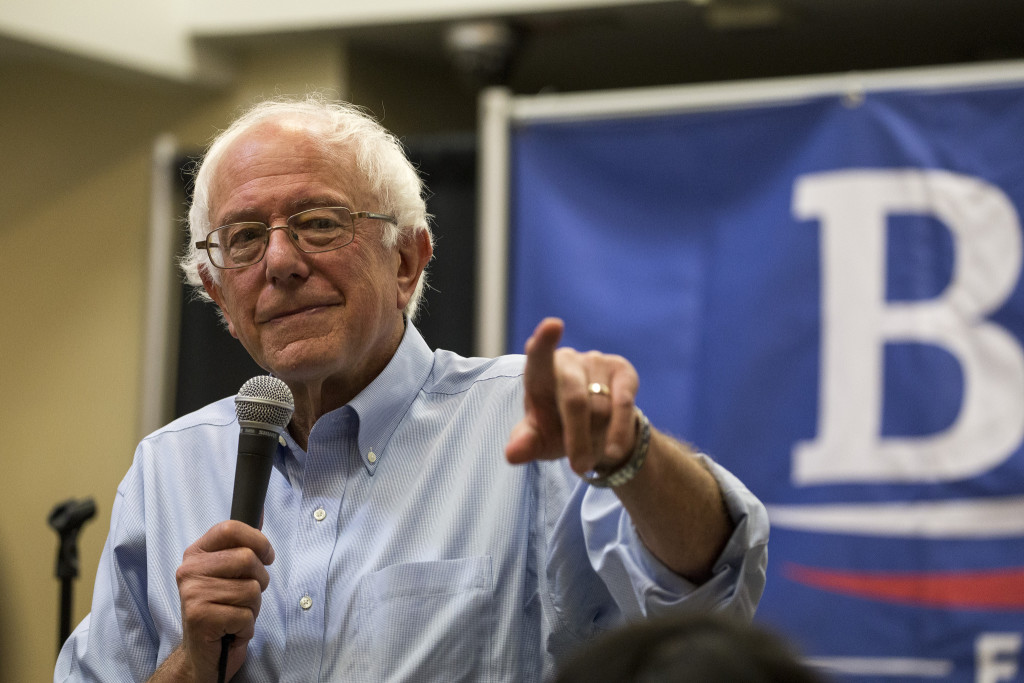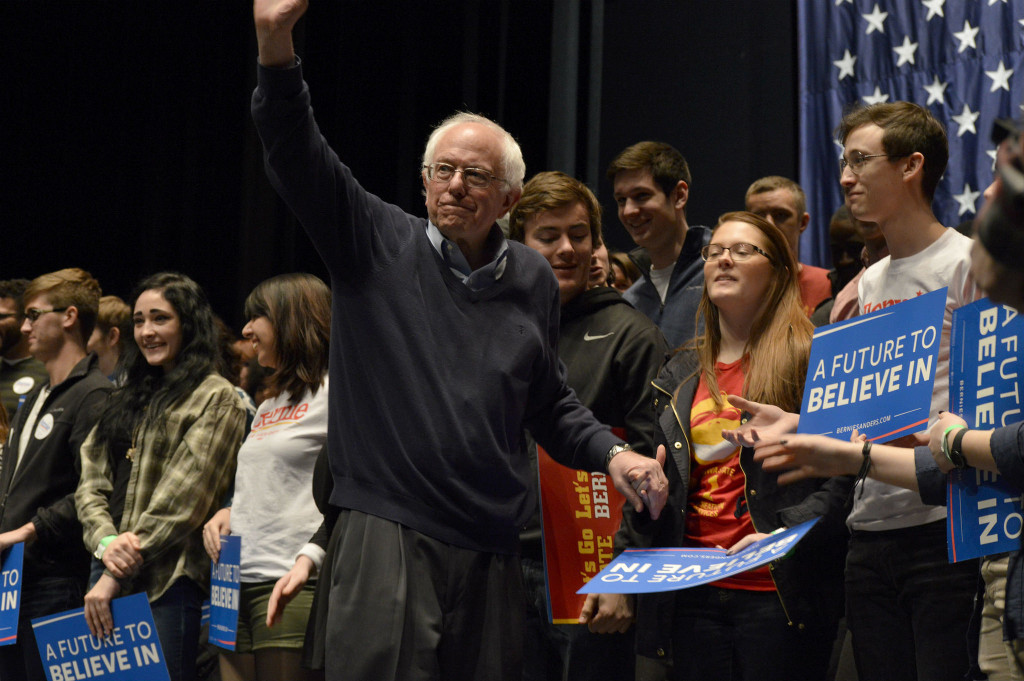It was a long Monday night in Iowa, laying bare the stark, bipolar split within the soul of the Democratic Party and the question of its future. Former Secretary of State Hillary Clinton received a shock to her nascent campaign, as Vermont Senator Bernie Sanders’ populist message of comprehensive campaign finance reform, greater income equality, and free tuition continued to garner appeal and traction among the young, motivated, and disenchanted. The kind of government, politics, and culture that Sanders embodies may have bulldozed the assumed narrative that Clinton would ascend to the nomination, but it cannot realistically reach a tipping point within the next ten months that could catapult him into the Oval Office. Even if Sanders were to ride his populist wave into the White House, he would find himself grappling with a livid Congress at worst, and a tepid Senate at best, let alone pools of corporate and dark money set to undermine his agenda.
Sanders’ movement provides a necessary gadfly for the Democratic party, if it is to move forward and continue the real and substantial social change begun by Presidents Bill Clinton and Barack Obama. But a gadfly does not govern. A gadfly compels larger forces to react. And in Sanders’ case, his rallying call prompts supporters to action, and his conservative opponents into retreat. Sanders has become a gadfly for the Democratic party, but he has not become its leader—let alone its ideal candidate for the presidency.
Of particular note in this campaign has been the similarities between Sanders’ policy platform and Nordic-style socialism that has become political shorthand for universal healthcare, free education, and greater income equality. This portion of his campaign has even led to self-aware comments by Marco Rubio, where in January’s Fox News debate, he said Sanders “is a good candidate for president – of Sweden.” Sanders’ conception of the Nordic model has gained support by his followers, especially in a climate marked by increasing income inequality in a post-recession American economy. But even a cursory glance at the the challenges and outright frustrations the Democrats experience in getting Obamacare passed offers a foreboding future for any left-leaning social programs. In other words, the Nordic model would face considerable, sustained resistance within the GOP-held House, and beyond.
The version of the Affordable Care Act that ended up becoming law was initially envisioned by the conservative think-tank Heritage Foundation, which designed a law that was ostensibly influenced by and for the insurance industry—a business sector that is hardly in favor of socialist programs. As the GOP fought in Congress and the courts against Obamacare, the measure has remained the law of the land. Unraveling the program still remains as a top-line priority for Republicans, even as it continues to garner support and success across the 50 states. The Affordable Care Act is a staple of right-wing, anti-Obama propaganda, and serves as a dog whistle against ever-creeping Soviet-style socialism. Opposition to this law will not end as Obama leaves office; in fact, it will only intensify. In each Republican debate, the candidates promise to repeal Obamacare in its entirety. A Republican presidential candidate cannot survive without this fundamental vow.
What’s more, congressional gridlock will not magically disappear under a Sanders presidency. Throughout his two terms, Obama has demonstrated himself on the whole to be a conservative moderate on domestic and foreign policy, from Obamacare to a relatively-unfettered Wall Street to the Trans-Pacific Partnership international trade agreement. If Sanders were to enjoy a groundswell of support that would prove crucial for a successful term, a monumental cultural shift in values would need to occur across the United States.
FLY IN THE OINTMENT
Since 1990, Sanders has crafted himself as a stalwart congressional gadfly, representing a small and progressive state—even by New England’s standards. Sanders only joined the Democratic party last year ahead of his run for president, and has positioned himself for decades as a left-leaning independent open to collaboration with the Democrats of varying stripes. This model is more than common in European parliaments, where smaller parties collaborate and align to pass policy measures and gain majority seating, but is a complete rarity in the American system. Domestically, hyper-polarization rules the day, making such coalitions impossible both for now and the foreseeable future.
President Sanders would need to exchange his collaborative independence for the role of chief executive—requiring him to work with the Democratic machine as well as his partisan rivals to achieve his grand progressive goals. In the rare cases where this has succeeded, such as FDR’s New Deal and LBJ’s Civil Rights Act, there has been considerable pressure and horse-trading involved. In these examples, the president has had friends on both sides of the aisle. Instead, Sanders has no real and substantial congressional support, and does not have the backing of elites within the Democratic party. In fact, according to Nate Silver’s fivethirtyeight.com, as of February 2, Sanders has exactly two endorsements, both in the House.
When the Tea Party revolted against the GOP establishment, it found its legislative power and voice in the grassroots disenchantment and rancor at the district and representative level. That dissent then worked its way through state legislatures and even into the U.S. Senate. Sanders’ public appeal has yet to turn into a network of grassroots politicians working their way through local government in similar numbers. Without a crop of politicians hell-bent on remedying inequality, there will be no left-wing insurgency to back a Sanders presidency.
The left wing of the Democratic party is putting its eggs in Bernie’s basket, and may be fighting an ideological battle that primes it to lose the electoral war. The current populist groundswell behind the Sanders campaign exists entirely at the presidential level, without any real call and strategy to build a back-bench of Democratic challengers in lower-level campaigns that embody Sanders’ message. The Left has naively inverted the Tea Party strategy, risking the creation of a president with no congressional assistance that will fail to create legislation capable of surviving long enough for a floor vote. No amount of executive signing orders can remedy a sclerotic and hostile congress, especially for a candidate who is ideologically opposed to them in the first place.
Sanders’ domestic policy message is no doubt refreshing, and has clearly resonated with Democratic faithful and previously apolitical members of the public. The critical mass of voters Sanders’ campaign is creating, all in the name of ending the status quo in Washington, is admirable. However, if the American electorate is serious, constructive, and strategic in its desire to create Nordic model policies for itself, it will have to get beyond treating Sanders as a savior and a figurehead. Those who truly believe in Bernie’s message must work from the ground up and use this second opportunity to cultivate anti-inequality politicians after squandering the headway created by the Occupy movement. Lightning does not often strike twice, but Sanders has enabled that to happen. Instead of pursing a top-down approach, Sanders supporters should begin the political grunt work of raising candidates for lower-level elections and positions, changing political discourse where it matters most—on local and state levels.


